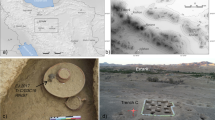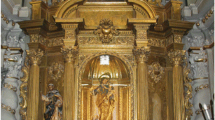Abstract
A series of sherds from the archeological site of Qotakalli in the area of Cusco (Perú), corresponding to four different Inka periods, were studied by means of square wave voltammetry of immobilized particles (VIMP) and electrochemical impedance spectroscopy (EIS). Ceramic microparticles were placed on a graphite working electrode and were characterized by VIMP and EIS in contact with 0.10 M H2SO4 aqueous electrolyte. Voltammetric features of the sherds, corresponding to the reduction of Fe(III) and Mn(IV) minerals and the oxidation of Fe(II), provided characteristic voltammetric features able to differentiate between different types of ceramic production and Inka periods. A consistent grouping was obtained from VIMP and EIS measurements, mainly responsive to porosity and microstructure variations of the ceramic samples, being also consistent with attenuated total reflectance—Fourier transformed infrared (ATR-FTIR) measurements, scanning electron microscopy (SEM), and optical and structural observations. Grouping of ceramic samples is important to support the archeological proposal of a diverse origin and production of pottery in Qotakalli.











Similar content being viewed by others
References
Chatfield M (2010) Tracing firing technology through clay properties in Cuzco, Perú. J Archaeol Sci 37(4):727–736
Cultrone G, Molina E, Arizzi A (2014) The combined use of petrographic, chemical and physical techniques to define the technological features of Iberian ceramics from the Canto Tortoso area (Granada, Spain). Ceram Int 40(7):10803–10816
Medeghini L, Mignardi S, De Vito C, Macro N, D’Andrea M, Richard S (2016) New insights on Early Bronze Age IV pottery production and consumption in the southern Levant: the case of Khirbat Iskandar, Jordan. Ceram Int 42(16):18991–19005
Sillar B (2000) Dung by preference: the choice of fuel as an example of how andean pottery production is embedded within wider technical, social, and economic practices*. Archaeometry 42(1):43–60
Hayashida FM (1999) Style, technology, and state production: Inka pottery manufacture in the Leche Valley, Peru. Lat Am Antiq 10(04):337–352
Shimada I, Häusler W, Hutzelmann T, Wagner U (2003) Early pottery making in northern coastal Peru. Part I: Mössbauer study of clays. Hyperfine Interact 150(1-4):73–89
De La Fuente GA (2011) Urns, bowls, and ollas: pottery-making practices and technical identity in the southern Andes during the late period (ca. A.D. 900—A.D. 1450) (Catamarca, Northwestern Argentine Region, Argentina). Lat Am Antiq 22(02):224–252
Schwedt A, Mommsen H (2004) Clay paste mixtures identified by neutron activation analysis in pottery of a Roman workshop in Bonn, Germany. J Archaeol Sci 31(9):1251–1258
Grifa C, De Bonis A, Langella A, Mercurio M, Soricelli G, Morra V (2013) A Late Roman ceramic production from Pompeii. J Archaeol Sci 40(2):810–826
Ballirano P, De Vito C, Medeghini L, Mignardi S, Ferrini V, Matthiae P, Bersani D, Lottici PP (2014) A combined use of optical microscopy, X-ray powder diffraction and micro-Raman spectroscopy for the characterization of ancient ceramic from Ebla (Syria). Ceram Int 40(10):16409–16419
Medeghini L, Fabrizi L, De Vito C, Mignardi S, Nigro L, Gallo E, Fiaccavento C (2016) The ceramic of the “Palace of the Copper Axes” (Khirbet al-Batrawy, Jordan): a palatial special production. Ceram Int 42(5):5952–5962
Mirti P, Davit P (2004) New developments in the study of ancient pottery by colour measurement. J Archaeol Sci 31(6):741–751
De Benedetto GE, Laviano R, Sabbatini L, Zambonin PG (2002) Infrared spectroscopy in the mineralogical characterization of ancient pottery. J Cult Herit 3(3):177–186
Medeghini L, Lottici PP, De Vito C, Mignardi S, Bersani D (2014) Micro-Raman spectroscopy and ancient ceramics: applications and problems. J Raman Spectrosc 45(11-12):1244–1250
Maltoni S, Silvestri A, Maritan L, Molin G (2012) The Medieval lead-glazed pottery from Nogara (north-east Italy): a multi-methodological study. J Archaeol Sci 39(7):2071–2078
De Vito C, Medeghini L, Mignardi S, Orlandi D, Nigro L, Spagnoli F, Lottici PP, Bersani D (2014) Technological fingerprints of black-gloss ware from Motya (Western Sicily, Italy). Appl Clay Sci 88:202–213
Barone G, Lo Giudice A, Mazzoleni P, Pezzino A, Barilaro D, Crupi V, Triscari M (2005) Chemical characterization and statistical multivariate analysis of ancient pottery from Messina, Catania, Lentini and Siracusa (Sicily)*. Archaeometry 47(4):745–762
Scholz F (1998) In: Bard Allen J (ed) Electroanalytical Chemistry. Marcel Dekker, Inc., New York
Scholz F, Gulaboski R, Doménech-Carbó A (2014) Electrochemistry of immobilized particles and droplets, 2nd edn. Springer, Berlin
Doménech-Carbó A, Scholz F (2013) Electroanalytical chemistry for the analysis of solids: characterization and classification (IUPAC technical report). Pure Appl Chem 85:609–631
Doménech-Carbó A, Costa V (2009) In: Scholz F (ed) Monographs in electrochemistry series. Springer, Berlin
Doménech-Carbó A, Sánchez-Ramosa S, Doménech-Carbó MT, Gimeno-Adelantado JV, Bosch-Reig F, Yusá-Marco DJ, Saurí-Peris MC (2002) Electrochemical determination of the Fe(III)/Fe(II) ratio in archaeological ceramic materials using carbon paste and composite electrodes. Electroanal 14(10):685–696
Sánchez Ramos S, Bosch Reig F, Gimeno Adelantado J, Yusá Marco D, Doménech Carbó A (2002) Application of XRF, XRD, thermal analysis, and voltammetric techniques to the study of ancient ceramics. Anal Bioanal Chem 373(8):893–900
Doménech-Carbó A, Doménech-Carbó MT, Osete-Cortina L (2001) Identification of manganese(IV) centers in archaeological glass using microsample coatings attached to PolymerFilm electrodes. Electroanal 13(11):927–935
Doménech-Carbó M-T, Doménech-Carbó A, Osete-Cortina L, Saurí-Peris MC (2006) A study on corrosion processes of archaeological glass from the Valencian region (Spain) and its consolidation treatment. Microchim Acta 154(1-2):123–142
Di Turo F, Montoya N, Piquero-Cilla J, De Vito C, Coletti F, De Luca I, Doménech-Carbó A (2018) Electrochemical discrimination of manufacturing types of pottery from Magna Mater Temple and Fora of Nerva and Caesar (Rome, Italy). Appl Clay Sci 162:305–310
Doménech-Carbó A, Villegas M-Á, Agua F, Martínez-Ramírez S, Doménech-Carbó MT, Martínez B (2016) Electrochemical fingerprint of archeological lead silicate glasses using the voltammetry of microparticles approach. J Am Ceram Soc 99(12):3915–3923
Rice PM (1987) Pottery analysis: a sourcebook. The University Chicago Press, Chicago
De Bonis A, Cultrone G, Grifa C, Langella A, Leone AP, Mercurio M, Morra V (2017) Different shades of red: the complexity of mineralogical and physico-chemical factors influencing the colour of ceramics. Ceram Int 43(11):8065–8074
Macdonald DD, Sikora E, Engelhardt G (1998) Characterizing electrochemical systems in the frequency domain. Electrochim Acta 43(1-2):87–107
Cano E, Lafuente D, Bastidas DM (2010) Use of EIS for the evaluation of the protective properties of coatings for metallic cultural heritage: a review. J Solid State Electrochem 14(3):381–391
Redondo-Marugán J, Piquero-Cilla J, Doménech-Carbó MT, Ramírez-Barat B, Sekhaneh WA, Capelo S, Doménech-Carbó A (2017) Characterizing archaeological bronze corrosion products intersecting electrochemical impedance measurements with voltammetry of immobilized particles. Electrochim Acta 246:269–279
Chen G, Waraksa CC, Cho H, Macdonald DD, Mallouka TE (2003) EIS studies of porous oxygen electrodes with discrete particles: I. Impedance of oxide catalyst supports. J Electrochem Soc 150(9):E423–E428
Park J-J, Pyun S-I (2003) Analysis of impedance spectra of a pitted Inconel alloy 600 electrode in chloride ion-containing thiosulfate solution at temperatures of 298–573 K. J Solid State Electrochem 7(6):380–388
Lee S-J, Pyun S-I (2007) Assessment of corrosion resistance of surface-coated galvanized steel by analysis of the AC impedance spectra measured on the salt-spray-tested specimen. J Solid State Electrochem 11(6):829–839
Mancey DS, Shoesmith DW, Lipkowski J, McBride AC, Noël J (1993) An electrochemical investigation of the dissolution of magnetite in acidic electrolytes. J Electrochem Soc 140(3):637–642
Encinas P, Lorenzo L, Tascón ML, Vázquez MD, Sánchez-Batanero P (1994) Electrochemical study of iron(II) and iron(III) compound mixtures in the solid state. Application to magnetite characterization. J Electroanal Chem 371(1-2):161–166
Grygar T (1996) The electrochemical dissolution of iron(III) and chromium(III) oxides and ferrites under conditions of abrasive stripping voltammetry. J Electroanal Chem 405(1-2):117–125
Grygar T (1997) Dissolution of pure and substituted goethites controlled by the surface reaction under conditions of abrasive stripping voltammetry. J Solid State Electrochem 1(1):77–82
Grygar T (1998) Phenomenological kinetics of irreversible electrochemical dissolution of metal-oxide microparticles. J Solid State Electrochem 2(3):127–136
Singh RN, Singh JP, Lal B, Thomas MJK, Bera S (2006) New NiFe2−xCrxO4 spinel films for O2 evolution in alkaline solutions. Electrochim Acta 51(25):5515–5523
Doménech-Carbó A, Sabaté F, Sabater MJ (2018) Electrochemical analysis of catalytic and oxygen interfacial transfer effects on MnO2 deposited on gold electrodes. J Phys Chem C 122(20):10939–10947
De Guzman RN, Shen YF, Shaw BR, Suib SL, O'Young CL (1993) Role of cyclic voltammetry in characterizing solids: natural and synthetic manganese oxide octahedral molecular sieves. Chem Mater 5(10):1395–1400
Mutombo P, Hackerman N (1997) Potential decay behavior of iron in dilute nitric acid. J Solid State Electrochem 1(3):194–198
Fetisov VB, Ermakov AN, Belysheva GM, Fetisov AV, Kamyshov VM, Brainina KZ (2004) Electrochemical dissolution of magnetite in acid solutions. J Solid State Electrochem 8:565–571
Doménech A, Lastras M, Rodríguez F, Osete L (2013) Mapping of corrosion products of highly altered archeological iron using voltammetry of microparticles. Microchem J 106:41–50
Ivanova ND, Kirillov SA, Mishchenko AB (1993) Electrochemical behaviour of non-stoichiometric manganese oxide—hydroxide. Electrochim Acta 38(15):2305–2307
Amarilla JM, Tedjar F, Poinsignon C (1994) Influence of KOH concentration on the γ-MnO2 redox mechanism. Electrochim Acta 39(15):2321–2331
Bakardjieva S, Bezdička P, Grygar T, Vorm P (2000) Reductive dissolution of microparticulate manganese oxides. J Solid State Electrochem 4(6):306–313
Nodari L, Marcuz E, Maritan L, Mazzoli C, Russo U (2007) Hematite nucleation and growth in the firing of carbonate-rich clay for pottery production. J Eur Ceram Soc 27(16):4665–4673
Rathossi C, Pontikes Y (2010) Effect of firing temperature and atmosphere on ceramics made of NW Peloponnese clay sediments. Part I: reaction paths, crystalline phases, microstructure and colour. J Eur Ceram Soc 30(9):1841–1851
Nagy S, Kuzmann E, Weiszburg T, Gyökeres-Tóth M, Riedel M (2000) Oxide transformation during preparation of black pottery in Hungary. J Radioanal Nucl Chem 246(1):91–96
Funding
This study was financially supported by the Convenio de Cofinanciamiento 018-2016-FONDECYT, the MINECO Project CTQ2017-85317-C2-1-P supported by MINECO, ERDF, and AEI funds.
Author information
Authors and Affiliations
Corresponding authors
Additional information
Publisher’s note
Springer Nature remains neutral with regard to jurisdictional claims in published maps and institutional affiliations.
Electronic supplementary material
ESM 1
(DOC 426 kb)
Rights and permissions
About this article
Cite this article
La-Torre-Riveros, L., Doménech-Carbó, A., Cabrera, C.R. et al. Solid-state electrochemical analysis of Inka pottery from Qotakalli archeological site in the Cusco (Perú) area. J Solid State Electrochem 23, 1541–1552 (2019). https://doi.org/10.1007/s10008-019-04243-3
Received:
Revised:
Accepted:
Published:
Issue Date:
DOI: https://doi.org/10.1007/s10008-019-04243-3




